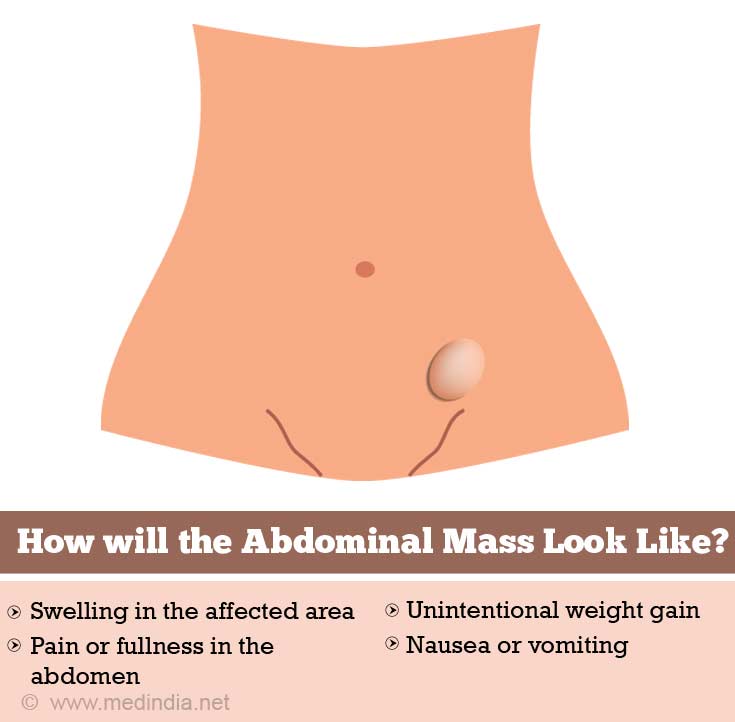- The American Cancer Society- Stomach Cancer Risk Factors - (https://www.cancer.org/cancer/stomach-cancer/causes-risks-prevention/risk-factors.html)
- MedlinePlus-Medical Encyclopedia: Abdominal mass - (https://medlineplus.gov/ency/article/003274.htm)
- American cancer society- Signs and Symptoms of Gastrointestinal Stromal Tumors - (https://www.cancer.org/cancer/gastrointestinal-stromal-tumor/detection-diagnosis-staging/signs-symptoms.html)
- National institute for health and care excellence- Suspected cancer: recognition and referral - (https://www.nice.org.uk/guidance/ng12/ifp/chapter/Symptoms-of-cancer-in-children-and-young-people)
- Abdominal Masses in Children: Neuroblastoma, Wilms tumor, and Other Considerations- Armand E. Brodeur, Garrett M. Brodeur - (http://pedsinreview.aappublications.org/content/12/7/196)
What is Abdominal Mass?
An abdominal mass is a lump in your abdomen or tummy. The abdominal mass may cause a visible swelling and also change the shape of your abdomen. The lump in your tummy is actually an abnormal tissue collection within the abdominal cavity. There are many important organs in your abdomen such as stomach, liver, kidneys and bladder, spleen, pancreas, intestines, uterus and ovaries in women and big blood vessels such as the aorta. The exact location of the mass, firmness and texture will help determine which organ is affected. The abdominal lump mass can be either benign or malignant.
What Causes Abdominal Mass?
A lump that can be seen or felt over the surface of the abdominal wall may be originating from the skin or from the fat or muscle beneath the skin and maybe a cyst, lipoma or a neuro-fibroma or tumor of the muscle. It may also be a hernia that originates from within the abdominal cavity and pops out due to weak abdominal musculature.
Lumps that originate from within the abdominal cavity do not appear on the skin surface unless they are large and because they are large they may distort the abdominal wall appearance.
Some large malignant tumors especially those that originate from fatty, fibrous or muscle tissues may take the whole of the abdomen while some tumors are restricted to one quadrant of the abdomen. The location of lump helps the doctor to understand which organs are possibly affected.
Right upper quadrant: Usually lumps from liver (cancer,
Left upper quadrant: Enlargement or tumor of the spleen, stomach (cancer), colon (colorectal cancer) or kidney (calculus, hydronephrosis) can cause a mass in this region.
Epigastrium: Tumors of the stomach (gastric adenocarcinoma), pancreas (abscess, pancreatic cancer).
Periumbilical: Hernia, aortic aneurysm, neuroblastoma.
Right lower quadrant: A tumor of the ovary (cyst, cancer), colon (colorectal cancer, diverticulitis), kidney (cancer, hydronephrosis).
Left lower quadrant: tumors of the ovary (cyst, cancer), colon (diverticulitis, colorectal cancer), Burkitt’s lymphoma (a rare tumor of the immune cells affecting the mesentery and ileo caecal valve).
Suprapubic and pelvis: distended bladder, pregnancy, a tumor of the uterus (fibroids, cancer), ovaries (cyst, cancer).
What are the Symptoms & Signs of Abdominal Mass?

- Swelling in the affected area
- Pain or fullness in the abdomen
- Nausea or vomiting
- Irregular bowel movements
- Unintentional weight gain
- An inability to urinate or pass stool
- Lumps in the groin
- Bruising, rash or unusual paleness due to anemia
- Rectal bleeding
- Vaginal bleeding, especially if that happens more than twelve months after menopause
- Acid reflux and jaundice may be present, if the liver is involved
- Pain during urination along with increased or decreased urination
- The presence of fever or a rapidly growing, pulsating mass or the development of a new lump is a serious sign and requires immediate medical attention












